 |
Canku Ota
|
 |
|
(Many Paths)
|
||
|
An Online Newsletter
Celebrating Native America
|
||
|
August 2013 - Volume
11 Number 8
|
||
|
|
||
|
Grayson Makes Bows,
Arrows Using 'Old Way'
|
||
|
by Will Chavez - Senior
Reporter The Cherokee Phoenix
|
||
|
credits: photos by Will
Chavez - Senior Reporter The Cherokee Phoenix
|
|
In his mind he divides the logs harvested from the tree and knows once the wood is aged he will have plenty of bow-making material. Once the wood is split and the bark and sapwood is gone, "a solid piece of hardwood" is left, Grayson said. Next he scrapes and carves the wood down to a growth ring. At this point, he draws the bow's shape on the wood, which is now about 4 feet in length. He chops around the drawing with an axe to start shaping the wood into a bow. "And then it takes very little rasping to finish it," he said. Once he has the bow's thickness where he wants it, he bends the wood to ensure it bends evenly. He also looks for stiff spots. "When you're looking for that stiff spot, you can run your fingers down the wood. Your fingers are really sensitive, and you can feel stiff spots. You can feel little humps," Grayson said. He added that too much wood in certain areas of the bow causes stiff spots, which must be shaved down. "Don't get in a hurry, especially when you get this far into it. Just take your time and slowly shave it."
He prefers using Bois d'arc wood that has seasoned four years, although a piece seasoned only a year will work, too. "I try to keep a steady supply of wood at my house that I can season out. I've got wood that's probably 20 years old." Area bow makers prefer the Bois d'arc (also called Osage-Orange and Horse-Apple) tree, but Grayson said Cherokees used other woods such as Yellow Locust, Hickory, Ash and Black Locust. Cherokee men in the old Southeastern homelands preferred to use Black Locust, he said. "It's a good wood, but it will not let you lie. If you don't make that Black Locust bow just right, it'll tell on you and it will start getting little compression cracks across the belly (center)." Grayson has been making bows for more than 20 years. He was named a Cherokee National Treasure in 1998 for his bow-making and flint-knapping skills. He now works as a historical interpreter demonstrating flint knapping and bow making in the Ancient Village at the Cherokee Heritage Center in Park Hill.
Grayson said the people who learned bow making from him still ask him questions. He shares what he knows but tells them to learn other bow makers' techniques. "I talk to other people about bow making even though I know how to do it...because you never know what you're going to learn." For the bow string, Cherokee men once used a strip of bear intestine stretched and twisted into a string. It was not the only thing used, but to them it was the best material, Grayson said. The skin of an older fox squirrel can also be used to make a string, as well as groundhog skin. He's also used the nape of a deer's neck and the tanned hide of deer. "Brain-tanned deer hide is really pretty stout, a lot stronger than what you would actually imagine, for just being a piece of leather," he said. For his arrow shafts, he searches for straight pieces of river cane. Other woods used for arrow shafts include Dogwood, Hickory, Black Locust and Yellow Locust. Arrow points were usually made of stone in ancient times, but Grayson said other materials may be used such as antler and bone. For instance, he makes some arrow points from ham bone.
For the fletching or feathers at the back end of the arrow, Grayson prefers turkey feathers because they are stiff, which gives the arrow good flight. Traditionally, two-feathered fletches were used, but Grayson uses a three-feathered fletch, which catches air better and spins the arrow. One of the last things Grayson does when he finishes shaping his bow is rub it with bear fat to waterproof it and keep it flexible. He said constantly rubbing bear fat into it is also good for preservation and that he has 20-year-old bows he can still use for hunting. Grayson advises the people he teaches to learn to make a bow the old way, using minimal modern tools, because then they always have the tools in nature to make bows and arrows. "Learn how it's done the old way first, and then you can start using metal and taking shortcuts here and there." |
||
|
|
||
|
|
||
| Canku Ota is a free Newsletter celebrating Native America, its traditions and accomplishments . We do not provide subscriber or visitor names to anyone. Some articles presented in Canku Ota may contain copyright material. We have received appropriate permissions for republishing any articles. Material appearing here is distributed without profit or monetary gain to those who have expressed an interest. This is in accordance with Title 17 U.S.C. Section 107. | ||
|
Canku Ota is a copyright ©
2000 - 2013 of Vicki Williams Barry and Paul Barry.
|
||
 |
 |
|
|
The "Canku
Ota - A Newsletter Celebrating Native America" web site and
its design is the
|
||
|
Copyright ©
1999 - 2013 of Paul C. Barry.
|
||
|
All Rights Reserved.
|
||
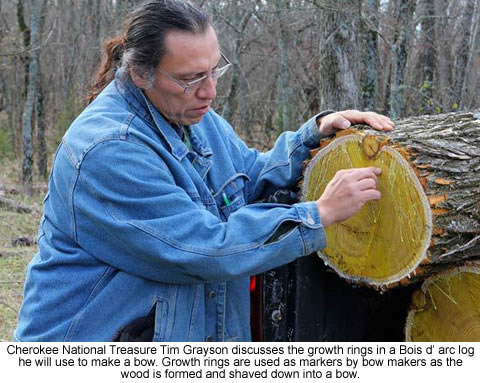 TAHLEQUAH,
OK. – As Cherokee National Treasure Tim Grayson inspects a
large Bois d'arc tree, he can see the bows he will produce from
it before he cuts it down.
TAHLEQUAH,
OK. – As Cherokee National Treasure Tim Grayson inspects a
large Bois d'arc tree, he can see the bows he will produce from
it before he cuts it down.
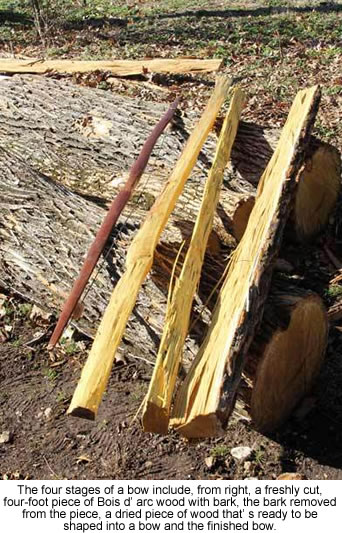
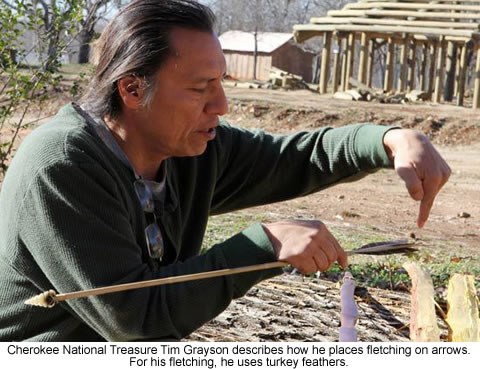
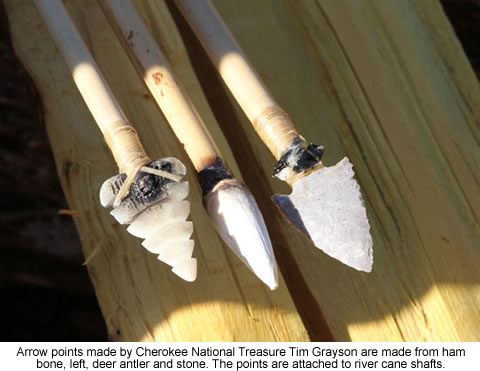
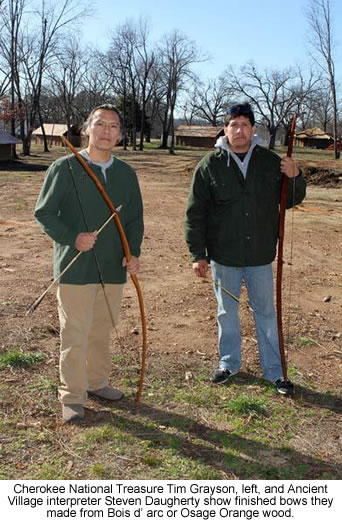 "You
can use cow bone. You can use buffalo. You can use deer," he said.
He added that an arrow's weight and speed depends on the point's
weight. "Light arrows are fast, but heavy arrows penetrate better.
Heavier arrows aren't affected by the wind as much. People always
ask me if I have certain arrows for certain game. To me it's one
size fits all."
"You
can use cow bone. You can use buffalo. You can use deer," he said.
He added that an arrow's weight and speed depends on the point's
weight. "Light arrows are fast, but heavy arrows penetrate better.
Heavier arrows aren't affected by the wind as much. People always
ask me if I have certain arrows for certain game. To me it's one
size fits all."